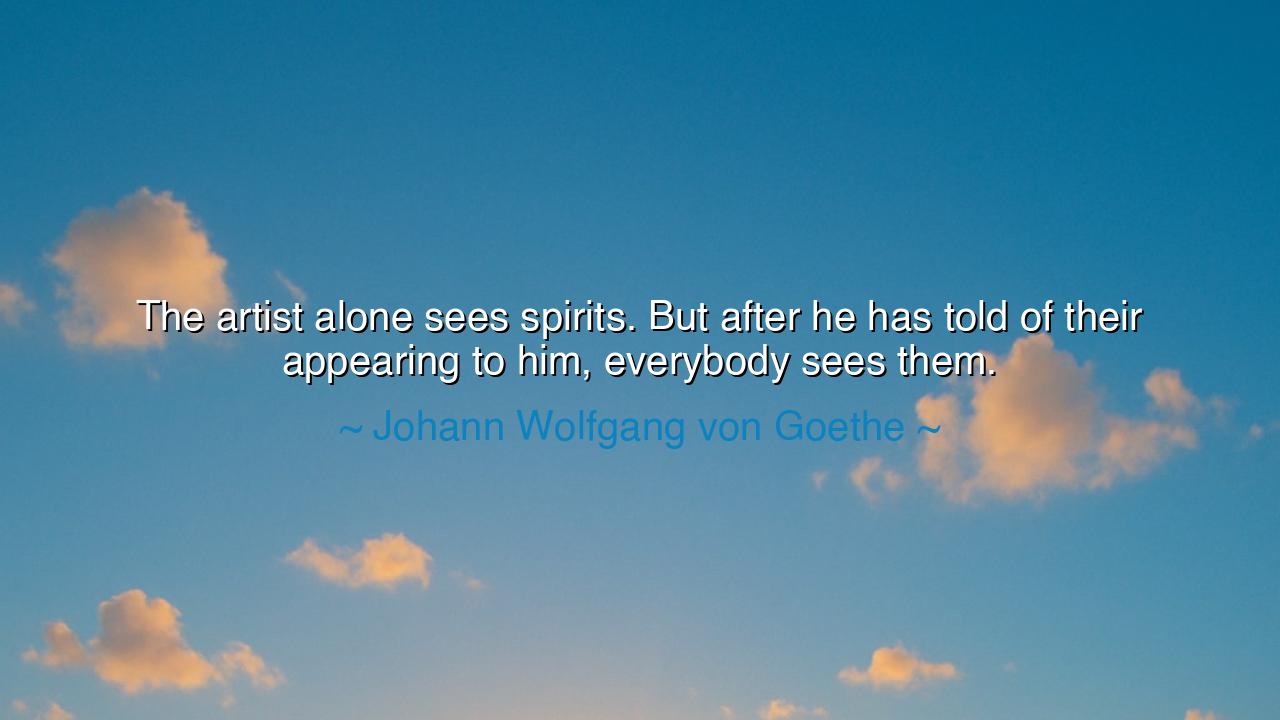
The artist alone sees spirits. But after he has told of their
The artist alone sees spirits. But after he has told of their appearing to him, everybody sees them.






In the luminous words of Johann Wolfgang von Goethe, the poet-philosopher of Germany, he proclaimed: “The artist alone sees spirits. But after he has told of their appearing to him, everybody sees them.” In these words lies the mystery of creation, the divine fire that burns within the soul of the artist — that rare being who perceives what others cannot yet see, and gives form to the invisible. Goethe, whose works bridged science, philosophy, and poetry, understood that art is not imitation but revelation. The artist is the seer of the unseen, the one who hears whispers from realms beyond reason and translates them into language, color, and song. Before he speaks, the vision is his alone; after he speaks, it becomes the world’s.
When Goethe speaks of “spirits,” he does not refer merely to ghosts or phantoms, but to ideas, emotions, and truths that dwell in the hidden chambers of the human soul. These spirits are the forces of inspiration — fleeting, delicate, and often beyond the grasp of the ordinary mind. The artist, through sensitivity and suffering, becomes the vessel through which they appear. He feels what others do not yet feel; he senses what others pass by unseen. To the rest of the world, reality is solid and still; but to him, it trembles with life. His art is the act of making visible the invisible, of drawing forth the divine breath that hides within all things.
Thus, when the artist reveals his vision, the veil lifts for all. The spirits that once danced in his solitude now stand before humanity, clothed in paint, or word, or sound. And the miracle is this: after the revelation, others begin to see them too. The poet’s sorrow becomes the reader’s; the painter’s dream becomes a shared memory. Through art, the private revelation becomes a universal awakening. The artist has shown not something foreign to man, but something deeply his own — only he saw it first, and dared to name it.
Consider the story of Vincent van Gogh, a man who saw colors that others could not see, light that others could not feel. In his lifetime, his paintings were mocked and misunderstood — his spirits too strange for the world to recognize. Yet after his death, his visions became the very eyes through which millions see beauty. What he once saw alone — the burning stars, the trembling wheat fields, the sorrowful faces — now live in the hearts of all who behold them. Goethe’s words find their truth here: the artist suffers the solitude of vision, that others might inherit its radiance.
So it is in every age. The artist walks where others fear to tread: into the silence, into the storm, into the depths of despair or ecstasy. He wrestles with the unseen forces of life until they take form in his hands. He is both prophet and craftsman, both sufferer and revealer. For art is born not of comfort, but of communion with the eternal. The spirits come not to those who flee silence, but to those who embrace it. And when they come, the artist must listen — must endure the weight of the vision — and then release it, that the world might be transformed.
From this, dear listener, comes the great teaching: do not doubt the reality of what only you can see. Every great creation begins as a solitude, every truth as a whisper in one soul. If you are given a vision, honor it. If you feel the pull of beauty or meaning unseen by others, do not dismiss it as madness or vanity. The artist is not greater than others — he is merely more faithful to what he perceives. Through his courage, he gives form to the collective longing of humankind.
And so, let us remember Goethe’s wisdom: that the artist sees spirits first, but only through his voice do the rest of us awaken to their presence. This is the sacred task of art — to bridge the visible and the invisible, to turn the private revelation into a public light. For when the artist speaks, the unseen becomes seen, and the world itself grows wider, deeper, more alive. Therefore, cherish the artists among you, and the artist within you. For they are the torchbearers of vision — and through their eyes, we learn to see the soul of the world.






AAdministratorAdministrator
Welcome, honored guests. Please leave a comment, we will respond soon